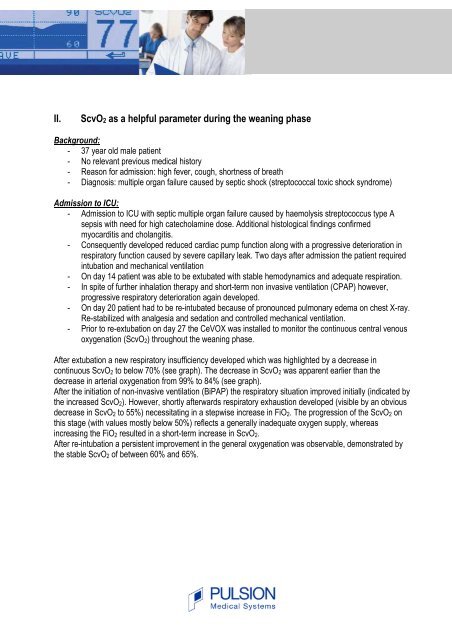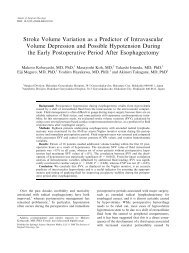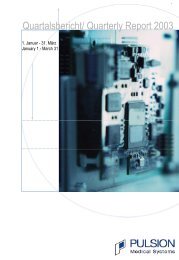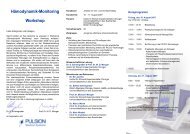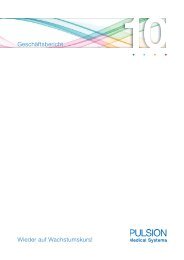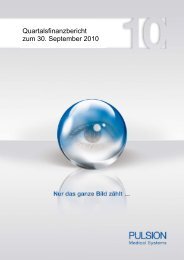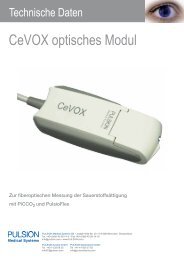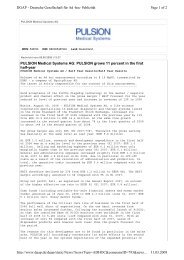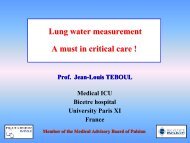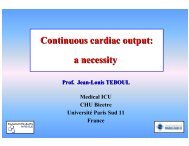II. ScvO2 as a helpful parameter during the weaning phase
II. ScvO2 as a helpful parameter during the weaning phase
II. ScvO2 as a helpful parameter during the weaning phase
You also want an ePaper? Increase the reach of your titles
YUMPU automatically turns print PDFs into web optimized ePapers that Google loves.
<strong>II</strong>. <strong>ScvO2</strong> <strong>as</strong> a <strong>helpful</strong> <strong>parameter</strong> <strong>during</strong> <strong>the</strong> <strong>weaning</strong> ph<strong>as</strong>e<br />
Background:<br />
- 37 year old male patient<br />
- No relevant previous medical history<br />
- Re<strong>as</strong>on for admission: high fever, cough, shortness of breath<br />
- Diagnosis: multiple organ failure caused by septic shock (streptococcal toxic shock syndrome)<br />
Admission to ICU:<br />
- Admission to ICU with septic multiple organ failure caused by haemolysis streptococcus type A<br />
sepsis with need for high catecholamine dose. Additional histological findings confirmed<br />
myocarditis and cholangitis.<br />
- Consequently developed reduced cardiac pump function along with a progressive deterioration in<br />
respiratory function caused by severe capillary leak. Two days after admission <strong>the</strong> patient required<br />
intubation and mechanical ventilation<br />
- On day 14 patient w<strong>as</strong> able to be extubated with stable hemodynamics and adequate respiration.<br />
- In spite of fur<strong>the</strong>r inhalation <strong>the</strong>rapy and short-term non inv<strong>as</strong>ive ventilation (CPAP) however,<br />
progressive respiratory deterioration again developed.<br />
- On day 20 patient had to be re-intubated because of pronounced pulmonary edema on chest X-ray.<br />
Re-stabilized with analgesia and sedation and controlled mechanical ventilation.<br />
- Prior to re-extubation on day 27 <strong>the</strong> CeVOX w<strong>as</strong> installed to monitor <strong>the</strong> continuous central venous<br />
oxygenation (<strong>ScvO2</strong>) throughout <strong>the</strong> <strong>weaning</strong> ph<strong>as</strong>e.<br />
After extubation a new respiratory insufficiency developed which w<strong>as</strong> highlighted by a decre<strong>as</strong>e in<br />
continuous <strong>ScvO2</strong> to below 70% (see graph). The decre<strong>as</strong>e in <strong>ScvO2</strong> w<strong>as</strong> apparent earlier than <strong>the</strong><br />
decre<strong>as</strong>e in arterial oxygenation from 99% to 84% (see graph).<br />
After <strong>the</strong> initiation of non-inv<strong>as</strong>ive ventilation (BiPAP) <strong>the</strong> respiratory situation improved initially (indicated by<br />
<strong>the</strong> incre<strong>as</strong>ed <strong>ScvO2</strong>). However, shortly afterwards respiratory exhaustion developed (visible by an obvious<br />
decre<strong>as</strong>e in <strong>ScvO2</strong> to 55%) necessitating in a stepwise incre<strong>as</strong>e in FiO2. The progression of <strong>the</strong> <strong>ScvO2</strong> on<br />
this stage (with values mostly below 50%) reflects a generally inadequate oxygen supply, where<strong>as</strong><br />
incre<strong>as</strong>ing <strong>the</strong> FiO2 resulted in a short-term incre<strong>as</strong>e in <strong>ScvO2</strong>.<br />
After re-intubation a persistent improvement in <strong>the</strong> general oxygenation w<strong>as</strong> observable, demonstrated by<br />
<strong>the</strong> stable <strong>ScvO2</strong> of between 60% and 65%.
Conclusion:<br />
The respiratory exhaustion post extubation because of incre<strong>as</strong>ed work of breathing and worsening oxygen<br />
absorption w<strong>as</strong> reliably reflected by <strong>the</strong> CeVOX <strong>ScvO2</strong>. Initiating non-inv<strong>as</strong>ive ventilation with incre<strong>as</strong>ed<br />
FiO2 w<strong>as</strong> immediately accompanied by an incre<strong>as</strong>e in <strong>ScvO2</strong>. Only after re-intubation could a persistent<br />
stabilization in <strong>ScvO2</strong> be ensured (see graph).<br />
In this c<strong>as</strong>e report <strong>the</strong> continuous me<strong>as</strong>urement of <strong>ScvO2</strong> reflected <strong>the</strong> repeated changes between<br />
respiratory exhaustion and temporary recovery.<br />
The respiratory deterioration that occurred post extubation w<strong>as</strong> recognized a lot earlier by <strong>the</strong> continuous<br />
me<strong>as</strong>urement of <strong>ScvO2</strong> than by <strong>the</strong> me<strong>as</strong>urement of arterial saturation (see graph).<br />
Graph:<br />
SaO2 99%<br />
Trend of <strong>ScvO2</strong><br />
SaO2 84%<br />
Stepwise incre<strong>as</strong>e in FiO2<br />
because of respiratory<br />
exhaustion


